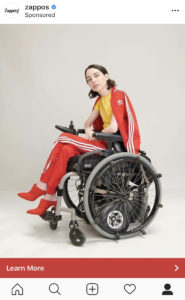How An Instagram Ad Got Me Thinking About Adaptive Fashion
by Sydney
 As I was scrolling through Instagram on my way home from work the other day (taking the train, of course! Don’t Instagram and drive!) I came across an ad sandwiched between photos of a dripping ice cream cone and someone’s baby.
As I was scrolling through Instagram on my way home from work the other day (taking the train, of course! Don’t Instagram and drive!) I came across an ad sandwiched between photos of a dripping ice cream cone and someone’s baby.
The stylized Instagram pic featured a sleek, chic woman in an Adidas track suit, jacket draped over her shoulders in the effortless way I could never pull off. Sitting in a wheelchair, she had one leg crossed over the other, sporting red slip-on booties so cool you immediately daydream of the scenario in which you’d wear them.
The copy below the image advertised a new adaptive line from Zappos.com, and when I visited the page I saw keywords for browsing like “easy on/off shoes” and “adaptive jeans”, “magnetic closures” and “diabetic shoes”. The results for women’s selections clocked in at 823 items. Featured among the pieces are affordable and stylish staples like this black swing dress that’s sensory friendly and this four-way reversible scoop jersey top.
If you’re a regular on the Easterseals blog, you know that we’ve taken a keen interest in adaptive fashion over the past few years. It’s clear why: In today’s age of social media, we’re eager to express ourselves and our style. We want to wear clothes that tell the world how we see ourselves and how we want the world to see us. We want to feel comfortable and confident and clad in pieces that, well, look good. For people with disabilities though, sometimes finding clothes that are adaptive come at the expense of personal style. Maybe that’s why seeing this ad among the mishmash of my Instagram feed gave me pause; fashion and accessibility and style intersected in a way that felt authentic and cool.
As Erin Hawley, Digital Producer for Easterseals Thrive, shared in a previous post: “Modified clothing has been out there for some time, but the styles are usually expensive, hideous, in limited production, or a combination of all three. It’s hard to find items with magnetic snaps, comfortable seams, elastic waists, or sensory-friendly wear.” She adds earlier in the piece, “As an adult, I still have trouble finding age-appropriate clothing that fit my small frame and appeal to my personal style. I’m 32 years old, and I don’t want to wear Elsa and Anna t-shirts (even though I love Frozen).”
Don’t get me wrong: I work with and know plenty of people with disabilities who infuse their style into their everyday wardrobe. But when we look at the big picture, it’s plain to see that the fashion industry is at a crossroads when it comes to designing clothes with people with disabilities in mind. As we’ve discussed here before, there are companies making great strides towards progress (looking at you, Tommy Hilfiger and Target). But wouldn’t it be fabulous to see options in any mall store and big box retailer? We’re moving in the right direction, but we need to get there faster.
Stay tuned for part two!






